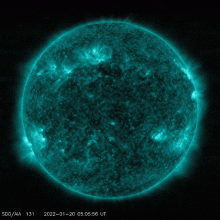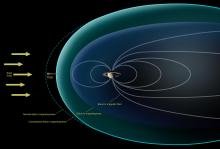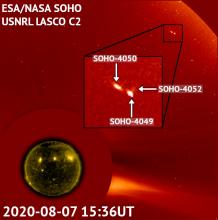Listen to today's episode of StarDate on the web the same day it airs in high-quality streaming audio without any extra ads or announcements. Choose a $8 one-month pass, or listen every day for a year for just $30.
You are here
Stormier Skies
Space weather could be especially stormy this year. A forecast issued late last year said the Sun’s current cycle of magnetic activity should peak sometime this year. And the peak should be a lot more intense than predicted in earlier forecasts. That could mean more problems for satellites and other technology.
Space weather is powered by magnetic activity on the Sun. That activity goes through a cycle that peaks roughly every 11 years. At the peak, the Sun produces more sunspots and solar flares — bif explosions of particles and energy.
As those waves pass by Earth, they can zap orbiting satellites. They also heat the outer atmosphere, increasing the drag on satellites, shortening their lifetimes. In addition, Earth’s magnetic field directs charged particles toward the surface. The particles can knock out power grids, and force airlines to re-route flights across the north polar regions. So accurate forecasts are critical for the folks who maintain those important services.
The past couple of solar cycles have been especially quiet. And the current cycle was expected to follow that pattern, reaching its peak in 2025. Instead, the level of solar activity has been much higher than forecast. That suggests the current cycle will peak earlier than originally expected — sometime from January to October of this year. And the peak will be more active — revving up the intensity of space weather.
Script by Damond Benningfield






